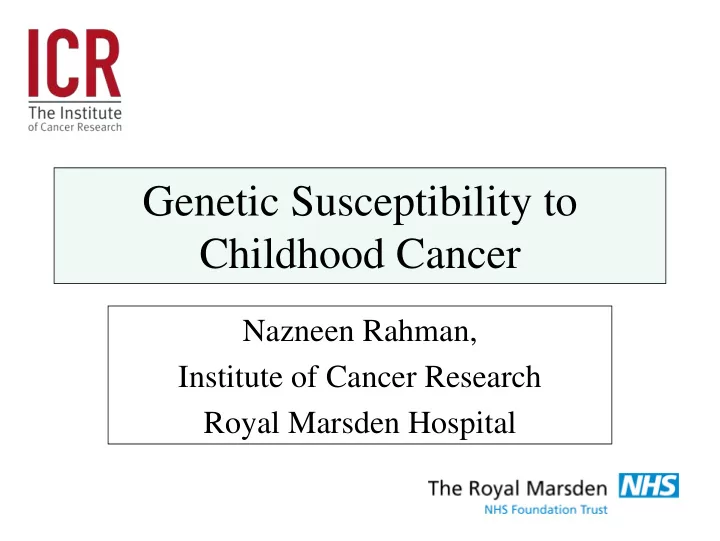

Genetic Susceptibility to Childhood Cancer Nazneen Rahman, Institute of Cancer Research Royal Marsden Hospital
There are two types of cancer gene • Faulty genes that are present in egg or sperm and that are therefore present in every cell. Cancer predisposition genes. • Faulty genes that are only present in the cancer itself not the rest of the body. Somatically mutated cancer genes
Cancer genes • ~400 genes known to be involved in cancer (~1% human genes). • 90% of known genes show somatic mutation, 20% germline and 10% both.
CANCER GENES gain of function loss of function activated in tumours inactivated in tumours Oncogenes Tumour suppressor genes
Genetic mutations High / moderate / small increases cancer risk Clustering of cases Unusual phenotype Isolated cases ‘familial’ ‘syndromic’ ‘sporadic’
Genetic mutations High / moderate / small increases cancer risk Clustering of cases Unusual phenotype Isolated cases ‘familial’ ‘syndromic’ ‘sporadic’
Familial childhood cancer • Familial forms of most cancers reported, but overall contribution to the cancer is very variable. • Many causative genes identified by linkage analysis. • Retinoblastoma ( RB1 ) , Wilms tumour ( WT1 ), neuroblastoma ( ALK ), medulloblastoma ( SUFU ).
Retinoblastoma • Embryonal tumour of the retina • 1 in 20,000 ~40 in UK per year • 30% bilateral • 15% family history of retinoblastoma • Due to RB1 mutations. Rb1 is a key regulator of cell cycle and of chromatin • Paradigm for Knudson’s two-hit hypothesis
Retinoblastoma Knudson’s two-hit hypothesis Tumour Genetic mut wt mut mut wt wt mut wt mut mut Non-genetic
Retinoblastoma • All familial cases are genetic – 50% risk recurrence and offspring risk • Most bilateral, non-familial cases are genetic and due to de novo mutations – 50% offspring risk • 15% unilateral RB due to de novo mutations -50% offspring risk • Remainder have two somatic RB1 mutations in the tumour, are not genetic, no risk to relatives
Genetic testing in retinoblastoma • Blood test in all children with retinoblastoma • If mutation found, can offer ‘cascade’ genetic testing to at-risk family members Allows: • Targeting / avoidance of surveillance • EUA from 2-3 weeks to 5yo (14 anaesthetics)
Genetic mutations High / moderate / small increases cancer risk Clustering of cases Unusual phenotype Isolated cases ‘familial’ ‘syndromic’ ‘sporadic’
Childhood cancer syndromes • Most childhood cancer syndromes are caused by mutations in tumour suppressor genes – Easier to inactivate rather than activate genes. – Better tolerated by an embryo. • Mutation predisposes to cancer, it does not cause cancer alone, other events/mutations are required. • Cancers due to germline mutations more likely to - occur at younger age - be bilateral/multifocal - be associated with other features
Childhood cancer syndromes Syndrome Mechanisms • Fanconi anaemia • Recessive genes • DNA repair syndromes • Dominant genes • NF1 • De novo genes • MEN • Cytogenetic abnormalities • Denys-Drash • Epigenetic defects • DICER1 syndrome • WAGR • Beckwith-Wiedemann
W ilms- A niridia- G enitourinary-mental R etardation (WAGR) syndrome PAX6 11p13 WT1 100% aniridia Genito-urinary abnormalities Wilms tumour (30-50%) Insidious renal disease
Fanconi Anaemia • Rare, highly heterogeneous condition characterised by distinctive cellular phenotype, skeletal abnormalities, bone marrow suppression and risk of malignancy
Genetic mutations High / moderate / small increases cancer risk Clustering of cases Unusual phenotype Isolated cases ‘familial’ ‘syndromic’ ‘sporadic’
‘Sporadic’ childhood cancer • Sometimes due to syndromic genes but other features not present (e.g. WT1 , SUFU ). • Sometimes due to ‘familial’ genes but reduced penetrance means relatives not affected ( DICER1 , INI1 ) • Sometimes associated risks are only slightly increased (GWAS variants)
Association studies SNP ..ACTGGGCTAGGAACATTAGAGCCCCGTTACACTTTCC.. ..ACTGGGCTAGGAACATTATAGCCCCGTTACACTTTCC.. Analyse hundreds of thousands of common genetic variants in cases and controls in 1000s of samples.
SNP association studies CASES CONTROLS
Genome-wide association study • Analogous to linkage study – mapping common variants and exploiting linkage disequilibrium. • 100,000s SNPs analysed can capture all common variation.
GWAS studies • Successful in all cancers analysed (and many other diseases) to date, including childhood cancers such as neuroblastoma, Wilms tumour, leukemia. • Risks conferred very small (RR1.1 – 1.7), which limits clinical utility. • Variants often not in genes and cause of the association often not known.
Finding more genetic variants • Various strands of evidence indicate that (many) other genetic variants that contribute to childhood cancer remain to be identified. • Likely that genetic variants makes a contribution to every type of childhood cancer, but extent variable. • New sequencing technologies are likely to yield new discoveries.
DNA sequencing and gene discovery • Direct interrogation of genetic code can identify most classes of genetic variant. • Until recent years very expensive and laborious and limited to ‘candidate’ genes. • Successfully identified many cancer predisposition genes ( TP53 in Li Fraumeni, BUB1B in MVA, Fanconi anemia genes).
Next-Generation Sequencing • Extraordinary advances in sequencing technologies over last 5 years. • Now possible to analyse thousands of genes or the whole genome quickly and (relatively!) cheaply. • Revolutionising gene discovery.
Exome sequencing • The ‘exome’ refers to all protein coding genes ~20,000 • Can analyse 200 exomes per month / sequencer @£250 each. • Has already led to discovery of more syndromic childhood cancer genes. • Familial childhood cancer, sporadic cancers……
FACT study • Factors associated with childhood tumours study. • Aims to identify and characterise genes predisposing to childhood cancer. • National study. We recruit: – Any child with solid tumor – Familial childhood cancer clustering. – Childhood cancer cases with unusual phenotype.
Why research into genetic susceptibility? • Direct clinical benefit. • Insights into cancer causation. • Insights into fundamental mechanisms and developmental processes. • Much still to discover and understand.
Recommend
More recommend